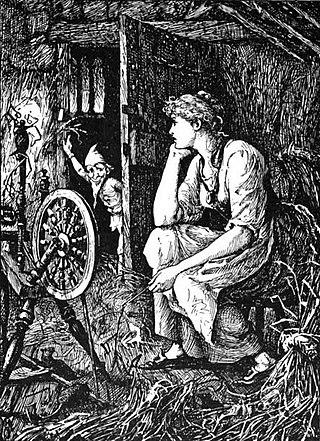
"The Golden Goose" is a fairy tale collected by the Brothers Grimm.

The Frog Princess is a fairy tale that has multiple versions with various origins. It is classified as type 402, the animal bride, in the Aarne–Thompson index. Another tale of this type is the Norwegian Doll i' the Grass. Eastern European variants include the Frog Princess or Tsarevna Frog and also Vasilisa the Wise ; Alexander Afanasyev collected variants in his Narodnye russkie skazki, a collection which included folk tales from Ukraine and Belarus alongside Russian tales.

"The Master Maid" is a Norwegian fairy tale collected by Peter Christen Asbjørnsen and Jørgen Moe in their Norske Folkeeventyr. "Master" indicates "superior, skilled." Jørgen Moe wrote the tale down from the storyteller Anne Godlid in Seljord on a short visit in the autumn of 1842. Andrew Lang translated the tale to English and included it in his The Blue Fairy Book (1889). A later translation was made by George Dasent, in his Popular Tales from the North.

The Langs' Fairy Books are a series of 25 collections of true and fictional stories for children published between 1889 and 1913 by Andrew Lang and his wife, Leonora Blanche Alleyne. The best known books of the series are the 12 collections of fairy tales also known as Andrew Lang's "Coloured" Fairy Books or Andrew Lang's Fairy Books of Many Colors. In all, the volumes feature 798 stories, besides the 153 poems in The Blue Poetry Book.
"The Three Princesses of Whiteland" is a Norwegian fairy tale, collected by Norwegian writers Peter Christen Asbjørnsen and Jørgen Moe in their collection of folktales and legends Norske folkeeventyr (1879). Scottish poet and novelist Andrew Lang collected it his The Red Fairy Book (1890).

The Two Brothers is a German fairy tale collected by the Brothers Grimm, tale number 60. It is Aarne-Thompson type 303, "The Blood Brothers", with an initial episode of type 567, "The Magic Bird Heart". A similar story, of Sicilian origin, was also collected by author and folklorist Andrew Lang in The Pink Fairy Book.
"The Silent Princess" is a Turkish fairy tale, structured as a frame story with three inserted tales: "The Magic Pomegranate" ; "The Carpenter, the Tailor, and the Clergyman"; "Three Suitors at the Graveyard". Andrew Lang included it in The Olive Fairy Book.
The Dragon and the Prince or The Prince and the Dragon is a Serbian fairy tale collected by A. H. Wratislaw in his Sixty Folk-Tales from Exclusively Slavonic Sources, tale number 43. Andrew Lang included it in The Crimson Fairy Book.
"The Prince and the Princess in the Forest" is a Danish fairy tale collected by Evald Tang Kristensen (1843–1929) in Æventyr fra Jylland in 1881. Andrew Lang included it in his The Olive Fairy Book (1907).
"The Enchanted Canary" is a French fairy tale collected by Charles Deulin in Contes du roi Cambrinus (1874) under the title of Désiré d'Amour. Andrew Lang included it in The Red Fairy Book.

The Golden Lion is an Italian fairy tale collected by Laura Gonzenbach in Sicilianische Märchen. Andrew Lang included it in The Pink Fairy Book.
King Kojata or The Unlooked for Prince or Prince Unexpected is a Slavonic fairy tale, of Polish origin. Louis Léger remarked that its source was "one of the most important collections of Polish literature".

"The Twelve Brothers" is a German fairy tale collected by the Brothers Grimm in Grimm's Fairy Tales. Andrew Lang included it in The Red Fairy Book.

The King of England and his Three Sons is a Romani fairy tale collected by Joseph Jacobs in More English Fairy Tales. He listed as his source Francis Hindes Groome's In Gypsy Tents, where the informant was John Roberts, a Welsh Roma. Groome published the tale as An Old King and his three Sons in England.
The Snake Prince is an Indian fairy tale, a Punjabi story collected by Major Campbell in Feroshepore. Andrew Lang included it in The Olive Fairy Book (1907).
The Magic Book is a Danish fairy tale collected by Evald Tang Kristensen in Eventyr fra Jylland Andrew Lang included it in The Orange Fairy Book, listing it as translated by Mrs. Skavgaard-Pedersen.

In folklore and fantasy, an enchanted forest is a forest under, or containing, enchantments. Such forests are described in the oldest folklore from regions where forests are common, and occur throughout the centuries to modern works of fantasy. They represent places unknown to the characters, and situations of liminality and transformation. The forest can feature as a place of threatening danger, or one of refuge, or a chance at adventure.
Hanasaka Jiisan (花咲か爺さん), also called Hanasaka Jijii (花咲か爺), is a Japanese folk tale.
The Princess in the Chest, also known as The Princess in the Coffin is a Danish fairy tale. Andrew Lang included it in The Pink Fairy Book.
The Green Man of Knowledge is a Scottish folktale collected in 1954 and published in 1958, in the academic journal Scottish Studies. It is classified in the international Aarne-Thompson-Uther Index as tale type ATU 313, "Girl Helps the Hero Flee" or "The Magic Flight".








